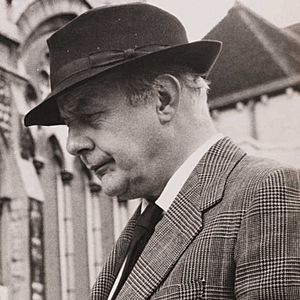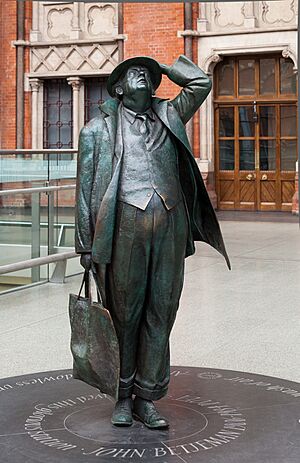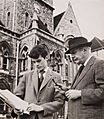John Betjeman facts for kids
Quick facts for kids
Sir
John Betjeman
|
|
|---|---|

Betjeman in 1961
|
|
| Poet Laureate of the United Kingdom | |
| In office 20 October 1972 – 19 May 1984 |
|
| Monarch | Elizabeth II |
| Preceded by | Cecil Day-Lewis |
| Succeeded by | Ted Hughes |
| Personal details | |
| Born |
John Betjemann
28 August 1906 London, England |
| Died | 19 May 1984 (aged 77) Trebetherick, Cornwall, England |
| Spouse |
Penelope Chetwode
(m. 1933; sep. 1972) |
| Domestic partner | Lady Elizabeth Cavendish |
| Children | 2 including Candida Lycett Green |
| Education | Marlborough College |
| Alma mater | Magdalen College, Oxford |
| Occupation | Poet, writer, broadcaster |
Sir John Betjeman (28 August 1906 – 19 May 1984) was a famous English poet, writer, and broadcaster. He was the Poet Laureate from 1972 until he passed away. He was a founder of The Victorian Society and loved Victorian architecture. He even helped save important buildings like St Pancras railway station from being torn down. John Betjeman started his career as a journalist and became one of Britain's most popular poets and a much-loved TV personality.
Contents
About John Betjeman
Early Life and School
John Betjeman was born John Betjemann in London. His family made silverware and ornamental furniture. During the First World War, his family changed their name to Betjeman, which sounded less German.
He went to several schools, including Highgate School, where the poet T. S. Eliot was one of his teachers. He also attended Marlborough College. While at Marlborough, he started a funny magazine called The Heretick. He also became interested in High Church Anglicanism, a type of Christian faith, which was important for his later writing.
University Days
Betjeman went to Magdalen College at the University of Oxford. He found it hard to get in because he struggled with math. At Oxford, he spent more time on his social life and studying church architecture than on his official courses. His tutor, C. S. Lewis, thought he was lazy.
He had a poem published in the university magazine Isis and was editor of the student newspaper Cherwell. He even brought his teddy bear, Archibald Ormsby-Gore, to college with him! This inspired his friend Evelyn Waugh to include a teddy bear in his famous book Brideshead Revisited. Betjeman wrote about his time at Oxford in his autobiography Summoned by Bells.
He left Oxford without finishing his degree, which bothered him for the rest of his life. However, he met many people there who would later influence his work.
After College
After leaving Oxford, Betjeman worked as a private secretary, a teacher, and a film critic. He also wrote for a high-society gossip column. From 1930 to 1935, he worked as an editor for the Architectural Review magazine. This time helped him improve his writing style.
In 1933, Betjeman married Penelope Chetwode. They had two children, Paul and Candida.
He helped create the Shell Guides, which were guidebooks for motorists exploring Britain's counties and historical sites. He wrote the guides for Cornwall and Devon.
During World War II, Betjeman worked for the Ministry of Information and later as a British press attaché in Dublin, Ireland. He wrote poems about his experiences in Ireland.
A Poet for Everyone
After the war, Betjeman continued writing books. His Collected Poems became very popular, selling 100,000 copies. This led to a film about him called John Betjeman: A Poet in London (1959).
Betjeman's poems are often funny and easy to understand. He used his friendly, slightly old-fashioned image on TV. His poems often describe everyday life in England, like old towns, seaside places, and bicycles. He wrote about things like Ovaltine and Robertson's marmalade, making his poems feel very real and relatable.
He was an Anglican (a type of Christian), and his faith shows in some of his poems. He believed that people are here to praise their Creator. He became Poet Laureate of the United Kingdom in 1972. This role, along with his TV appearances, helped his poetry reach even more people. He was able to express the feelings of many ordinary people while still being respected by other poets.
He even recorded four albums where his poetry was set to music! One of his well-known poems is "Slough", which he wrote to show his sadness about the industrial growth of the town.
Saving Old Buildings

John Betjeman loved Victorian architecture at a time when many people didn't appreciate it. He was a founder of The Victorian Society, which works to protect Victorian buildings. He wrote books and articles about architecture, including London's Historic Railway Stations (1972), where he defended the beauty of 12 railway stations. He also helped start the Friends of Friendless Churches in 1957.
He famously fought to save St Pancras railway station in London from being demolished. He called the plan to tear it down a "criminal folly." His efforts were very important in saving this beautiful station. When St Pancras was reopened as an international train station in 2007, a Statue of John Betjeman was placed there to honor him. The statue includes parts of his writings.
Betjeman also cared deeply about other cities, like Bath, which is famous for its Georgian architecture. He worked to protect Bath from modern developments.
His Legacy
For the last ten years of his life, Betjeman suffered from Parkinson's disease. He passed away at his home in Trebetherick, Cornwall, in 1984, at the age of 77. He is buried nearby at St Enodoc's Church.
Awards and Memorials
- The Society for the Protection of Ancient Buildings gives a John Betjeman award each year for repairing old places of worship.
- The John Betjeman Poetry Competition for Young People started in 2006 for 10- to 13-year-olds.
- There are many places named after him, including Betjeman Millennium Park in Wantage, Oxfordshire, and roads in Pinner and Chorleywood.
- A train engine on the Southend-on-Sea pier railway is named Sir John Betjeman.
- Several blue plaques mark places where he lived or worked in London and Oxfordshire.
- A bust of Betjeman is displayed outside the Vale and Downland Museum in Wantage.
Honors
- 1960: Queen's Medal for Poetry
- 1960: Appointed Commander of the Order of the British Empire (CBE)
- 1969: Appointed Knight Bachelor (Sir John Betjeman)
- 1972: Poet Laureate of the United Kingdom
- 2011: Honored by the University of Oxford as one of its 100 most distinguished members.
Works
Some of his well-known works include:
- Mount Zion (1932)
- Continual Dew (1937)
- An Oxford University Chest (1938)
- Old Lights for New Chancels: Verses Topographical and Amatory (1940)
- English Cities & Small Towns (1943)
- New Bats in Old Belfries (1945)
- Shropshire: A Shell Guide (1951)
- A Few Late Chrysanthemums (1954)
- Poems in the Porch (1954)
- The Collins Guide to English Parish Churches (editor) (1958)
- Summoned by Bells (1960)
- High and Low (1966)
- London's Historic Railway Stations (1972)
- A Nip in the Air (1974)
Partial Filmography
| Year | Title | Notes |
|---|---|---|
| 1959 | Monitor | A Poet in London |
| Journey into the Weald of Kent | Short film | |
| 1960 | Monitor | Journey into a Lost World |
| 1962 | In View | Men of Steam |
| John Betjeman Goes by Train: King's Lynn to Hunstanton | Short film | |
| Let's Imagine | Childhood in the Country | |
| 1962-3 | Betjeman's West Country | 9 episodes |
| 1963 | Let's Imagine | A Branch Line Railway |
| 1964 | Discovering Britain with John Betjeman | Short film series (10 films) |
| 1965 | Bristol My Home | TV Movie |
| 1967 | Betjeman's London | 6 episodes |
| The Picture Theatre | TV Movie | |
| 1968 | Contrasts | Marble Arch to Edgware |
| A Poet Goes North | TV Movie | |
| Summer 67 | The Isle of Wight in August | |
| 1969 | Bird's Eye View | Beside the Seaside |
| Bird's Eye View | An Englishman's Home | |
| 1970 | Railway's Forever | Short film |
| Four with Betjeman: Victorian Architects and Architecture | 4 episodes | |
| 1971 | Bird's Eye View | A Land of all Seasons |
| 1972 | Thank God It's Sunday | Short film |
| 1973 | Metroland | TV Movie |
| 1974 | A Passion For Churches | TV Movie |
| 1976 | Summoned By Bells | TV Movie |
Images for kids
-
The John Betjeman Centre Memorabilia Room showing the office from his home in Trebetherick
-
A bust of Betjeman in Wantage
See also
 In Spanish: John Betjeman para niños
In Spanish: John Betjeman para niños







